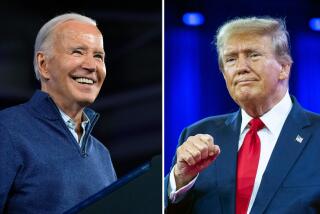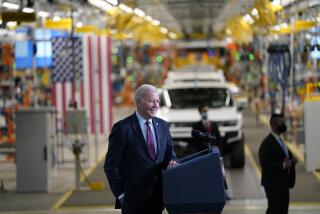Climate crisis or ‘hoax’: Where Biden and Trump stand on environmental policy

This was supposed to be the climate change election — or so many Democrats thought.
Then came the coronavirus.
But while climate change has taken a back seat to the pandemic and the struggling economy, it remains a major issue in the presidential election. Public concern about global warming was growing before the virus and, according to a Pew Research Center survey conducted this year, it is still top of mind for many voters.
President Trump and former Vice President Joe Biden, the Democratic nominee, hold radically different beliefs on climate policy as well as other environmental issues, such as clean energy infrastructure and land conservation.
The president’s views are essentially unchanged from 2016. He has alternated between calling climate change a “hoax” and acknowledging its existence. He has insisted that he’s an environmental champion for whom climate change is “very important.” Yet he has attacked energy-efficient light bulbs, claimed — with no evidence — that windmills cause cancer and aggressively promoted policies that would allow more planet-warming pollution.
Trump and Biden diverge on the coronavirus pandemic, Obamacare, Medicare and Medicaid, abortion rights, and how to rein in prescription drug prices.
Biden’s plans to tackle climate change have become more ambitious over the course of the campaign as he has worked to win the support of climate activists, young people and voters who backed his former rival Sen. Bernie Sanders of Vermont. Biden has promised to scrap all of Trump’s environmental rollbacks and set a firm deadline for moving the nation to net-zero emissions. For the former vice president, global warming is an era-defining challenge, and combating it is an economic opportunity. President Trump

Two attitudes have guided Trump’s climate policy from the earliest days of his administration: his skepticism of established science and his contempt for government regulation.
During his first term, Trump tried to roll back almost every rule put in place under former President Obama to lessen the effects of climate change.
His administration has weakened limits on greenhouse gas emissions from cars and trucks, as well as from the oil and gas industry. It has opened more public land to oil and gas drilling and limited wildlife protections. And it has relaxed pollution regulations on coal-fired power plants in an effort to revive the dying industry.
Trump campaigned on pulling the U.S. out of the Paris climate agreement, and he’s on track to make good on that promise the day after the Nov. 3 election.
California’s environmental protections have been a particular target for the president. The Trump administration has revoked the state’s authority to set tougher car emission standards than those required by the federal government, placing a major obstacle in California’s path to reducing greenhouse gas emissions and improving air quality.
More than two years into the Trump presidency, California has embraced its role as chief antagonist — already suing the administration more times than Texas took President Obama to court during eight years in office.
Most of these rollbacks face legal challenges from states and environmental advocates, and some are likely to remain unresolved until after the election.
Though Trump’s record on the environment has cost him support, he has continued to boast of his administration’s regulatory rollbacks and to attack his rival’s plans as an economic threat.
“The core of [Biden’s] economic agenda is a hard-left crusade against American energy,” Trump said during a Rose Garden speech in July.
Joe Biden
Biden has made tackling climate change a centerpiece of his campaign, proposing to invest $2 trillion in a massive green-jobs program to build renewable energy infrastructure.
The money, which would be spent over four years, would go toward energy-efficiency upgrades, the construction of 500,000 electric vehicle charging stations and greatly increasing the share of renewable energy from wind, solar and other technologies in America’s power sector.
His plan calls for ending the use of fossil fuels to generate electricity by 2035. By no later than 2050, he would bring the country to net-zero emissions of greenhouse gases under the plan.
Toward a more sustainable California
Get Boiling Point, our newsletter exploring climate change, energy and the environment, and become part of the conversation — and the solution.
You may occasionally receive promotional content from the Los Angeles Times.
Biden’s proposal surprised climate advocates with its ambition. It is significantly more aggressive than plans he put forward during the Democratic primary and incorporates policy ideas, such as investing in disadvantaged communities, that appeal to the liberal wing of the party and climate voters who were skeptical of him.
At the same time, Biden has tried to quiet fears from Democrats in Pennsylvania by assuring them that fracking, or hydraulic fracturing, will continue. His position remains that he would not allow new fracking on public lands, but that it should not be eliminated right now. “Fracking has to continue because we need a transition,” he said at a CNN town-hall-style event in September.
Biden has also promised to restore environmental protections undone by the Trump administration and rejoin the Paris climate agreement, committing to the pact’s goal of preventing global average temperatures from rising more than 2 degrees Celsius.
“Climate change is a challenge that’s going to define our American future,” he said in a speech announcing his plan. “I know meeting the challenge will be a once-in-a-lifetime opportunity to jolt new life into our economy, strengthen our global leadership, protect our planet. ... We’re not just going to tinker around the edges.”
More to Read
Get the L.A. Times Politics newsletter
Deeply reported insights into legislation, politics and policy from Sacramento, Washington and beyond. In your inbox three times per week.
You may occasionally receive promotional content from the Los Angeles Times.









